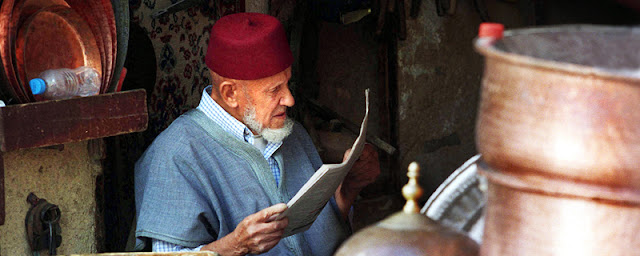Few travellers to Morocco ever find their way to Figuig, an oasis town on the Algerian border in the far east of the country. And that's a pity, as The View from Fez team found out from US Peace Corps volunteers, Jack and Ina Boatright. Figuig palmeraie
Figuig palmeraieIna and Jack are interested in promoting tourism to the area. But it would be a special kind of tourism, says Jack. Here's his report:
First impressions are that Figuig is an attractive, unique part of the Moroccan
Sahara. This is especially true for Zenaga, the oldest Ksar of the seven Ksours of this oasis. The most obvious element of Figuig is the vast palm grove, or palmeraie, of about 200,000 date palms.
Zenaga is a neighborhood or Ksar located within the palmeraie. Passageways through the Zenaga palmeraie are characterized largely by mud-brick walls that define both the gardens and the structure of the houses – sometimes as much as three stories high. Quite often, parts of the mud-brick houses extend over the many passageways, creating cool, dark, and quiet alleys even in the middle of bright sunny days.These passageways lend a mysterious and other-worldly air to Zenaga, especially with so many of the women of Zenaga covered head to toe in white, perhaps with only one eye exposed. You know that you are in a special place – like no other.

These passageways form intricate labyrinths that often only hint at the interior gardens and courtyards behind these mud walls. Here and there, one may see grape vines full of grapes, or branches of fig or pomegranate trees creeping over a wall.

The extensive network of passageways also serve the complex irrigation of the gardens. This means that many passageways have at least one or two narrow irrigation canals, (“fogarras” in Berber) running alongside it, often full of water and quietly gurgling at the abrupt twists and turn of these passageways.
There are almost no satellite TV dishes in Zenaga. Even in the desert on the way here, there are nomad tents that have solar collectors and the ubiquitous dishes.
Most of the people of Zenaga are in bed within two hours of sunset. The solitude is almost uncanny. As everywhere in Morocco, there are young men gathered together outside at night, but in Figuig they are amazingly polite and wholesome. Some of them have previously lived in Casablanca, Rabat or Oujda, but prefer the tranquility of Zenaga to the pressures of city living. It is almost like defying the law of gravity.
Although Zenaga is more than 800 years old and much of it created out of mud, or pise, it is not only still thriving but also beginning to experience a renaissance of sorts. Many of the homes are being cautiously restored, gently modernized and upgraded, while carefully preserving the nature and flavor of those ancient origins.These restorations are largely funded, not by true foreigners, but by the expatriate remittances of former Figuigians living abroad. They appreciate the unique nature of Zenaga and want their own piece of it in their future. Fortunately, there is no large-scale developer or even a development plan. The changes are taking place just one room, one courtyard, one house at a time.
Jack feels that even significant efforts at encouraging tourism in Figuig will not lead to a substantial increase as long as the border between Morocco and Algeria is closed. Also, the limitations of distance from the more populated areas of Morocco will protect the town from excessive outside influence. Their focus will be on fostering increased awareness and appreciation of Figuig to develop a modest increase in tourism that is environmentally clean, provides an economic resource, and that remains respectful to the unique cultural and religious lifestyle.
It's not going to be an easy job. There is very little information on accommodation in Figuig, though the Hotel Figuig is pleasant and there are a couple of guesthouses, Dar Amane and Auberge Oasis. There is no other tourist infrastructure, not even a bike rental outlet (and it's superb biking country), no taxis and no buses within the town. There's no Tourist Information Office, no maps, and even the postcards are faded!
 Figuig municipal gardens
Figuig municipal gardens But Jack maintains that there's plenty to do in a quiet, gentle sort of way. He recommends a tour of the palmeraie and Zenaga, mountain biking, visiting the natural springs in the underground hammam, visiting the nearby mountain caves that contain prehistoric drawings, bird-watching in the oasis, hiking the Azrou Trail, visiting local artisans and craftsmen and getting to know local families over tea and cakes.
Jack and Ina are to be congratulated on their efforts and we wish them well. They're a special kind of Peace Corps worker - one of a growing number of 'mature' volunteers who instead of enjoying their retirement at home, are making an enormous contribution to the lives of others.
To reach Figuig from Fez, take the train to Oujda (5 hours) and a bus to Figuig (7 hours). We said it was off the beaten track!
all photographs: Ina and Jack Boatright








